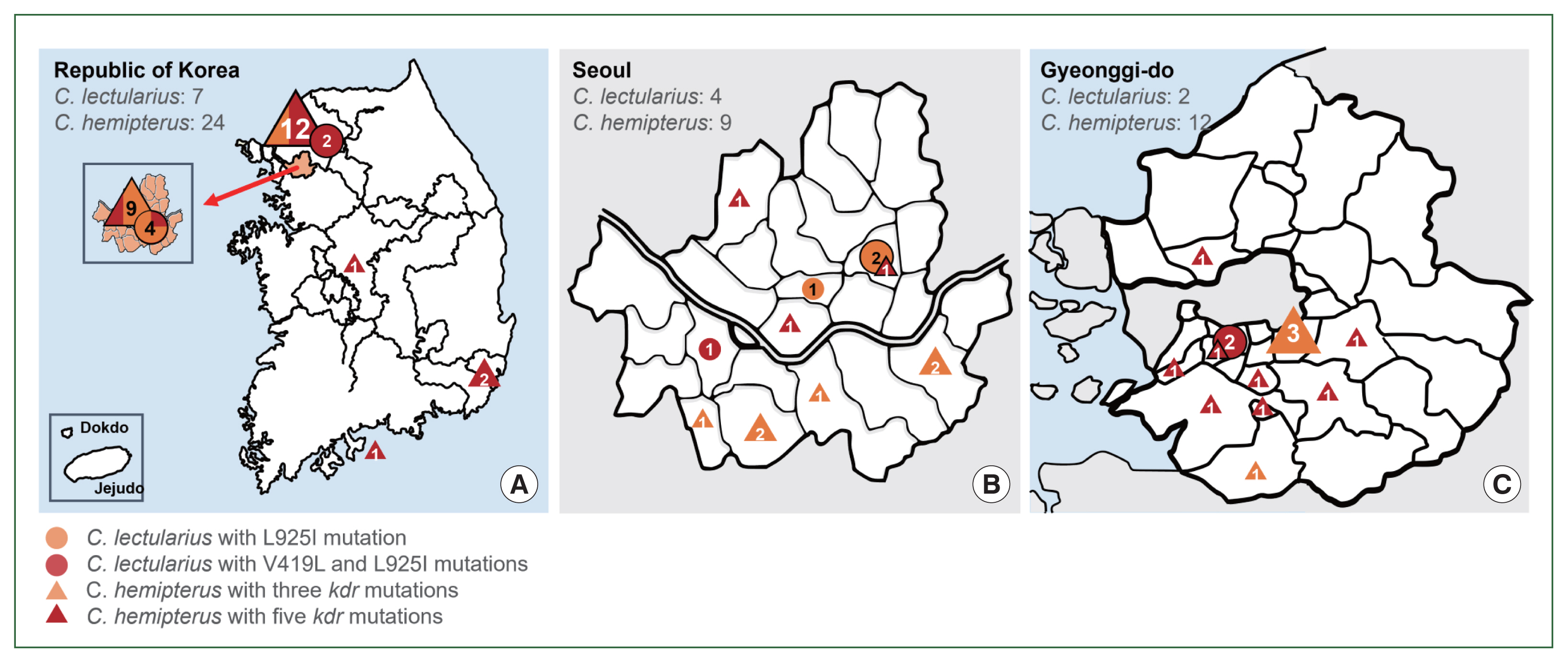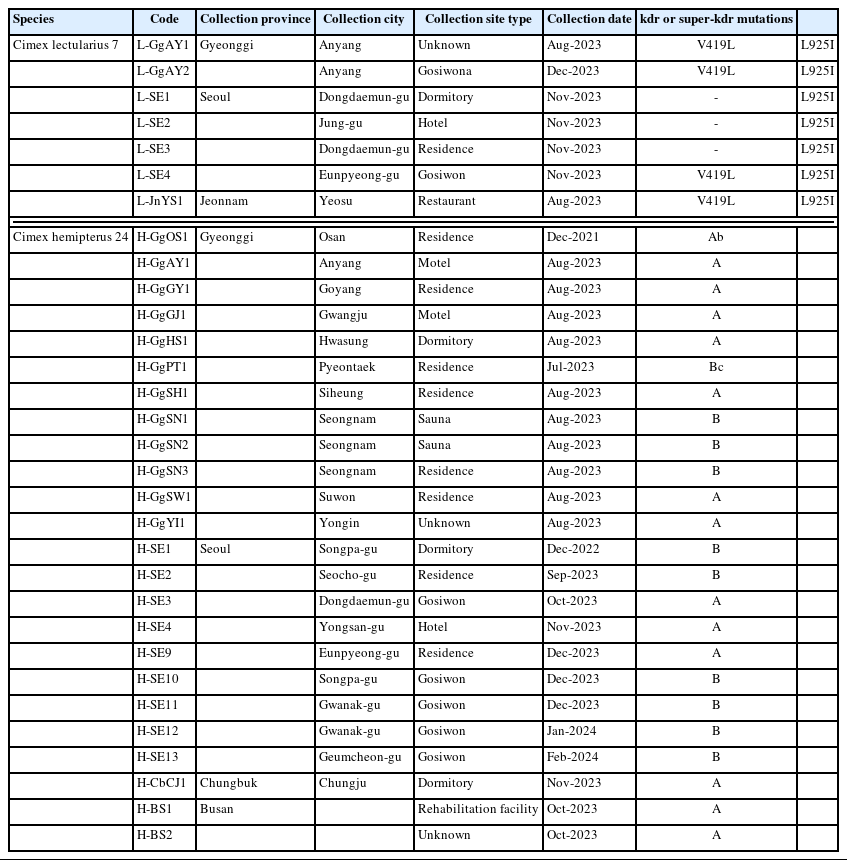Species identification and pyrethroid resistance genotyping of recently resurgent Cimex lectularius and Cimex hemipterus in Korea
Article information
Abstract
The global resurgence of bed bug infestations, exacerbated by increasing international travel, trade, and insecticide resistance, has significantly impacted Korea. This study identified the bed bug species and performed pyrethroid resistance genotyping of recently resurgent bed bugs in Korea. Thirty-one regional bed bug samples were collected from 5 administrative regions: Gyeonggi-do (n=14), Seoul (n=13), Busan (n=2), Jeonllanam-do (n=1), and Chungcheongbuk-do (n=1). The samples underwent morphological and molecular identification. Twenty-four regional samples (77.4%) were identified as the tropical bed bug, Cimex hemipterus, and the remaining 7 regional samples (22.6%) were identified as the common bed bug, Cimex lectularius. The C. hemipterus regional samples carried at least three mutations associated with knockdown resistance (kdr), including 2 super-kdr mutations. The 7 C. lectularius regional samples possessed at least one of the 3 kdr-related mutations associated with pyrethroid resistance. This study confirms that the prevalent bed bug species recently in Korea is C. hemipterus, replacing the previously endemic C. lectularius. Additionally, the rise in bed bug populations with pyrethroid resistance underscores the necessity of introducing alternative insecticides.
The past 2 decades have seen a global resurgence in infestations of 2 bed bug species: the common bed bug (Cimex lectularius Linnaeus, 1758) and the tropical bed bug (Cimex hemipterus Fabricius, 1803) [1]. In early October 2023 in Korea, anonymous claims circulated online about severe bed bug infestations in a sauna and university dormitory rooms. This issue quickly escalated and became the worst bed bug outbreak in Korea in the past several decades, causing significant social turmoil and concern nationwide (Supplementary Fig. S1). Consequently, since November 6th, 2023, the Korea Disease Control and Prevention Agency has actively monitored the resurgence of bed bugs in response to the escalating situation (https://www.kdca.go.kr/board/board.es?mid=a20513040000&bid=0131).
Cimex lectularius has been present at low densities in Korea over the past 20 years [2,3], whereas the recurrence of C. hemipterus was first reported in 2022 [4]. C. hemipterus is mainly distributed in tropical or subtropical regions, unlike C. lectularius, primarily found in temperate zones, including Korea [5]. However, since the mid 2010s, C. hemipterus infestations have been reported in nontropical regions [1]. Additionally, C. lectularius infestations have been reported in Costa Rica, the first reported location in Central America [6]. These findings indicate that there are few discernible climatic or environmental barriers to the distribution of these 2 bed bug species.
In recent decades, many bed bugs have developed resistance to pyrethroid insecticides. For instance, the knockdown resistance (kdr) trait in pyrethroid-resistant insect species is caused by mutations in the para-type voltage-sensitive sodium channel (vssc) gene [7]. In C. lectularius, three kdr mutations (V419L, L925I, and I936F) have been reported in this gene [8–10]; nine kdr mutations (L899V, M918I, D953G, L1014F, Y/L995H, V1010L, I1011F, V1016E, and L1017F/S) have been reported in C. hemipterus. Harboring both the M918I and L1014F mutations is known as super-knockdown resistance (super-kdr) in C. hemipterus [11,12]. The first case of C. hemipterus recently documented in Korea revealed the presence of these 2 super-kdr mutations, indicating the high potential of this bed bug for pyrethroid resistance [4]. Similarly, all C. lectularius samples collected after 2015 have been saturated with both resistance mutations (V419L and L925I) [2]. These findings suggest that pyrethroid resistance in bed bug populations in Korea has reached a critical level, requiring alternative insecticides. In this study, we surveyed recent bed bug infestations to determine the species composition of the resurgent bed bug populations in Korea and their kdr or super-kdr genotypes.
To this end, we collected bed bugs from 31 localities and conducted morphological and molecular identification of the species. Bed bugs were collected by pest control professionals, stored in 75% ethanol, and sent to the laboratory, where they were stored at −20°C until use. In some cases, live bed bugs were collected and maintained in the laboratory using artificial feeding systems, as previously described [10]. The blood-feeding protocol was reviewed and approved by the Institutional Review Board of Seoul National University (IRB No. E2302/004-005). Information on the collected bed bug samples is presented in Table 1. Following morphological identification, genomic DNA was extracted from single or multiple (2–5 individuals) adult bed bugs. As described previously, molecular identification was conducted on the mitochondrial cytochrome oxidase subunit I gene sequence [4]. The primers used in this study are listed in Supplementary Table S1.
Most of the bed bugs were collected from 14 sites in Gyeonggi-do, followed by 13 sites in Seoul Metropolitan City, 2 sites in Busan Metropolitan City, and one site each in Jeonnam and Chungbuk (Fig. 1; Table 1). This suggests that the current bed bug infestation is more concentrated in megapolitan areas. Of 31 regional bed bug samples, 24 were identified as C. hemipterus (77.4%), whereas the remaining 7 were identified as C. lectularius (22.6%). Most C. hemipterus samples were collected from private residences (9 sites), including 7 Gosiwons Gosiwons (a type of single-room occupancy building with low rent [13]) and dormitories (4 sites). C. lectularius specimens were mainly collected from private residences, including Gosiwons and a dormitory. This indicates that the recent resurgence of bed bugs in Korea is primarily attributed to C. hemipterus infestation in private residences. The dramatic increase in travel, particularly from tropical and subtropical areas after the termination of COVID-19 travel restrictions, likely contributed to the recent massive infestation by C. hemipterus in Korea. However, the precise reasons remain to be elucidated. Despite originating from tropical and subtropical areas, in this study, the C. hemipterus populations appear to successfully overwinter in heated residences in Korea, as previously observed in cold areas like Russia [14]. Nevertheless, whether they can successfully adapt and spread over multiple generations in temperate zones like Korea should be tracked.

Distribution of Cimex lectularius and Cimex hemipterus specimens collected in this study (A). The orange and red circles indicate C. lectularius specimens with only the L925I mutation and with both the V419L and L925I mutations, respectively. The orange and red triangles on the map indicate C. hemipterus specimens with 3 and 5 kdr mutations, respectively. The sizes of the symbols represent the relative number of collected samples in each district. Additional enlarged maps for Seoul (B) and Gyeonggi-do (C) are included, given that most recorded outbreaks occurred in these regions.
After bed bug species identification, species-specific genomic DNA fragments of the genomic DNA fragments of the vssc gene, flanking the kdr or super-kdr mutation sites, were PCR-amplified as previously described [2,4]. For C. lectularius, two separate vssc fragments, one containing the V419L mutation site in domain I S6 and the other containing the L925I and I936F mutation sites between domains II S4 and II S5, were amplified. For C. hemipterus, however, a single vssc fragment flanking the nine mutation sites (L899V, M918I, D953G, Y/L995H, A1007S, V1010L, I1011F, L1014F V1016E, and L1017F/S) was amplified between the domain II S4 loop and domain II S6. PCR was conducted as previously described [2,4] using the primers listed in Supplementary Table S1. The resulting PCR products were directly sequenced to identify the presence or absence of mutations.
Genotyping analyses for pyrethroid resistance alleles in the 24 C. hemipterus regional samples revealed that 14 regional samples harbored all five mutations (L899V, M918I, D953G, Y/L995H, and L1014F) associated with the super-kdr trait. The remaining 10 samples carried three mutations (M918I, Y/L995H, and L1014F). This suggests the presence of 2 distinct resistance haplotypes, one with 3 mutations and the other with 5, indicating the saturated status of pyrethroid resistance in these populations (Table 1; Fig. 1; Supplementary Fig. S2). Similarly, the 7 regional specimens of C. lectularius possessed at least one (L925I) of the 3 kdr-related mutations (V419L, L925I, and I936F) associated with pyrethroid resistance, with 4 regional specimens having both the V419L and L925I mutations (Table 1; Fig. 1; Supplementary Fig. S2). Interestingly, the remaining 3 regional specimens (L-SE1, L-SE2, and L-SE3) lacked the V419L mutation (Table 1), which is typically observed in C. lectularius specimens collected before 2015 in Korea [2]. No C. lectularius specimens examined in this survey carried the I936F mutation.
Considering that the 2 kdr mutations (V419L and L925I) in C. lectularius have been consistently present within the population even without pyrethroid selection pressure for more than 20 generations (Personal communication), the observation of C. lectularius populations lacking one of the 2 mutations likely indicates their recent invasion from abroad, particularly from regions with relatively less selection pressure by pyrethroids. Furthermore, this finding suggests that the overall level of pyrethroid resistance in C. lectularius populations is likely lower than that in C. hemipterus populations carrying at least 3 kdr mutations, as examined in this study. Nevertheless, no study has directly compared the actual pyrethroid resistance levels between the 2 bed bug species, each with different profiles of kdr mutation haplotypes. Therefore, there is a gap in our understanding of the comparative resistance patterns of C. lectularius and C. hemipterus. Thus, conducting a comparative bioassay with live specimens to determine differences in baseline susceptibility or resistance levels between the 2 bed bug species depending on their kdr genotypes would be beneficial. Additionally, information on other resistance mechanisms, including metabolic factors mediated by cytochrome P450 monooxygenases and cuticle-penetration factors, is needed to comprehensively understand the bed bug’s potential for resistance to pyrethroids and other insecticides. Implementing an integrated pest management strategy employing various physical and mechanical control methods is necessary to reduce the selection pressure by insecticides used for bed bug control [1]. As pyrethroid resistance genotypes and biological traits such as climbing ability [15] differ significantly between C. lectularius and C. hemipterus, immediate identification of bed bug species at infested sites is crucial for implementing the optimum control strategy against the target bed bug species, which may include the use of proper traps.
In conclusion, our findings demonstrate that the dominant species of bed bug in Korea is currently C. hemipterus, supplanting the previously endemic C. lectularius. Furthermore, pyrethroid resistance mediated by the target site insensitivity mechanism (i.e., via the kdr or super-kdr mutations in vssc) is widespread in the Korean populations of both species. Urgent attention is required to explore alternative insecticides to control these pyrethroid-resistant bed bugs effectively.
Supplementary Information
Acknowledgments
We would like to express our gratitude to the member companies of the Korea Pest Control Association and the Infectious Diseases Research Center, Citizen’s Health Bureau, Seoul Metropolitan Government that participated in collecting bed bug specimens. Ms. S. Cho was supported in part by the Brain Korea 21 Plus program. This work was supported by grants from the Korea Pest Control Association and Seoul National University Hospital.
Notes
The authors declare no conflict of interest related to this study.
Conceptualization: Lee SH, Kim JH
Data curation: Cho S, Kim HC
Formal analysis: Cho S, Kim JH
Funding acquisition: Lee SH, Kim JH
Resources: Kim HC, Eom H, Lee JR, Ko CH, Shin E, Lee WK
Supervision: Kim JH
Writing – original draft: Cho S, Lee SH, Kim JH
Writing – review & editing: Cho S, Kim HC, Shin E, Lee SH, Kim JH

